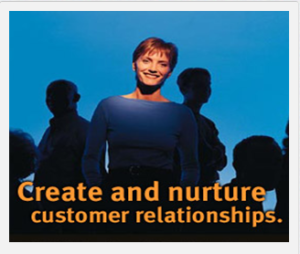Feelings have a critical role in the way customers are influenced. A favorite quote from David Freemantle. He knows how to market, yes?

Influencing customers.
Do you use feelings and emotions for influencing customers? They can make a stunning difference in capturing and holding their attention.
Check out our thoughts on customer focus.
Business is a “people activity” … people like to do business with people they know, like, and trust. Ones with whom they have relationships are at the top of the desirable business option list. The stronger the customer relationships, the greater will be their trust and loyalty in your business.
Related post: 10 Entrepreneur Lessons You Need to Know
Before I go into influencing new customers and relationship building, let me tell you a story from a local landscape business near my home. It will give you a great example of this subject.
This landscape gardener ran a business that had been in the family for two or three generations. The staff was happy, and customers loved to visit the store, or to have the staff work on their gardens or make deliveries – anything from bedding plants to ride-on mowers.
For as long as anyone could remember, the current owner and previous generations of owners were extremely positive happy people.
Most folks assumed it was because they ran a successful business.
In fact, it was the other way around…
A tradition in the business was that the owner always wore a big lapel badge, saying Business Is Great!
The business was indeed generally great, although it went through tough times like any other. What never changed, however, was the owner’s attitude, and the badge saying Business Is Great!
Everyone who saw the badge for the first time invariably asked, “What’s so great about business?” Sometimes people would also comment that their own business was miserable, or even that they were miserable or stressed.

Anyhow, the Business Is Great! Badge always tended to start a conversation, which typically involved the owner talking about lots of positive aspects of business and work, for example:
the pleasure of meeting and talking with different people every day
the reward that comes from helping staff take
on new challenges and experiences
the fun and laughter in a relaxed and healthy work environment
the fascination in the work itself, and in the other people’s work and businesses
the great feeling when you finish a job and do it to the best of your capabilities
the new things you learn every day – even without looking to do so
and the thought that everyone in business is blessed – because there are many millions of people who would swap their situation to have the same opportunities of doing a productive, meaningful job, in a well-fed civilized country, where we have no real worries.
And so the list went on. And no matter how miserable a person was, they’d usually end up feeling a lot happier after just a couple of minutes of listening to all this infectious enthusiasm and positivity.
It is impossible to quantify or measure attitude like this, but to one extent or another it’s probably a self-fulfilling prophecy, at which point if asked about the badge in a quiet moment, the business owner would confide:
The badge came first. Great business followed. And that my friends are the best way to influence customers that I know of.
Studies show time, and again, your best and most loyal customers are the aptest to tell their friends about your business, creating strong word-of-mouth marketing. Word-of-mouth marketing is the most important element of any marketing campaign.
Making new friends is becoming the most important element of social commerce. Creating positive experiences for building customer relationships often will take some serious thinking. But hopefully not at the expense of the things you can do to build customer relationships.
There are many companies that claim to be good at building customer influence and trust. Also about caring about what customers are left with after they’ve done it. Much less that truly earn that reputation … Walt Disney, Zappos, Dell, and Amazon, just to name a few that we follow and study.
Ask company executives of most companies if customers find their business trustworthy, and most will, of course, say yes. But ask their customers, and often you will hear a different answer.
In our book, the customer is the priority without hesitation. Why? Because gaining the confidence of your customers builds relationships and building relationships with customers gain their trust. Customers select businesses most often through their trust in the business and its people.

The need for a trust-based relationship can’t be denied. But marketing executives who want to build customer trust have one question: How?
Here is another great business experience we had recently that illustrates the points we want to make:
A few weeks ago, my wife and I entered a local furniture store we pass often. The arrangements always look perfect. The couches, tables, pillows, and art always seem very special. Unique in fact.
It was time for closing. Nevertheless, Nancy, a design consultant, happily stayed to talk to us.
She lives in our neighborhood, and we are casual friends. We arranged for her to visit our home to give us some design ideas.
She arrived at our home a week later for our first consultation. She measured our rooms. She took loads of photos. Spoke to our children and admired their rooms and the things that are part of their lives. She looked through our photo albums and got a glimpse of our history. It was interesting watching her get to know who we were and our likes.
My wife commented on how stunning she looked. She noticed her stylish and professional clothes and her perfume. A hint of vanilla.
She spent three hours with us. And she left with her iPhone filled with images, her mind filled with information, and ideas to fit what she had learned about us.
Last night, we stopped in to see what she had been working on.
Her design table was covered with fabrics. Pictures of furniture, of couches and tables, were everywhere. On her computer, I saw a 3D rendering of our home living spaces. It was where all her ideas and pieces were coming to life.
Once again, we stayed late, way past closing time. She served us designer chocolate and sparkling fruit soda. And once again, she was dressed stunningly. Her mannerisms were very professional and graceful.
When it was time to leave, my wife Kathy asked how much we owed her for the consultation.
“I’m waiving my fee,” she said. “It’s the holiday season. Spend it on your beautiful children. And yourselves. If you decide to come back and purchase from me, I’ll earn my fee then.”
It was an offer presented with no hint of pressure.
We exited through a side door. On the wall, a long list of words was displayed. I stopped to read them.
“These are our core values,” she said. “The things our owners built this business on and make every decision by daily. I read them when I open the store and again when I leave. It’s what we live by religiously.”
Suddenly, everything she had done made sense.
Kathy and I are going to do business with her. It may take the form of a couch. Or a table. But it’s her spirit and the soul of her company that will become part of our home.
The point, of course: words, mission statements, website copy, and professions of lofty ideals will only get you so far.
Making such things manifest in your customer interactions in every way possible, on the other hand, is how you stand out from the crowd.
How to market … our takeaways
The front line of any brand in the marketplace is not advertising, packaging, or product design. It is the interaction that the customer experiences that determine the brand’s reputation to a large degree. It is human and emotional, and at that critical time when a customer engages with one of your employees or someone in your channel, your brand (your product and reputation) will either be enhanced or diminished.
Almost any cost justifies those kinds of examples, and the cost hit by these two businesses take by doing this is paid back multiple times over by the customer loyalty they generate from making people happy.

So … a company’s brand communicates every time it touches a customer.
As a marketer, you need to manage this communication and be responsible for each moment of truth. These two business examples have this brand marketing down pat and recognize the value of branding your business.
Please share a brand-building story or two with us from your experience vault. Perhaps you’d like to add a comment or ask a question?
So what’s the conclusion? The conclusion is there is no conclusion. There is only the next step. And that next step is completely up to you.
It’s up to you to keep improving your customer influencing and brand marketing. Lessons are all around you. In many situations, your competitor may be providing the ideas and or inspiration. But the key is in knowing that it is within you already.
All you get is what you bring to the fight. And that fight gets better every day you learn and apply new lessons.
When things go wrong, what’s most important is your next step.
Need some help in finding ways to grow your customers? Such as creative ideas to help the differentiate with potential customers. Or perhaps finding ways to work with other businesses?
When things go wrong, what’s most important is your next step.
Try. Learn. Improve. Repeat.
When things are not what you want them to be, what’s most important is your next step. Call today.
Are you devoting enough energy to improving your continuous learning for yourself and your team?
Mike Schoultz is the founder of Digital Spark Marketing, a digital marketing and customer service agency. With 40 years of business experience, he blogs on topics that relate to improving the performance of your business. Find them on G+, Twitter, and LinkedIn.
Digital Spark Marketing will stretch your thinking and your ability to adapt to change. We also provide some fun and inspiration along the way. Call us for a free quote today. You will be amazed at how reasonable we will be.
Check out these additional articles on business and its performance from our library:
The Business Intelligence Process Part 3 Competitive Analysis
Competitive Growth Strategy … the Story of In-N-Out Burger
10 Entrepreneur Lessons You Need to Know
Collaboration and Partnerships Are Key to Business Growth
Like this short blog? Follow Digital Spark Marketing on LinkedIn or add us to your circles for 3-4 short, interesting blogs, and stories per week.
How to Market by Making a Stunning Difference with Examples

